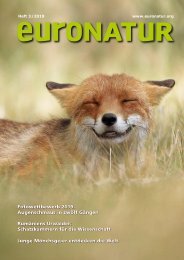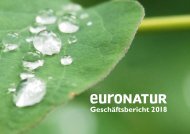Annual Report 2018 EuroNatur Foundation
Here you can get a good overview about our conservation programmes in Europe. Conatains also financial information.
Here you can get a good overview about our conservation programmes in Europe. Conatains also financial information.
You also want an ePaper? Increase the reach of your titles
YUMPU automatically turns print PDFs into web optimized ePapers that Google loves.
Photo: MOm / Panos Dendrinos -<br />
Mediterranean monk seal (Monachus monachus)<br />
Hope for the Mediterranean monk seal<br />
Geographical location in Europe<br />
Northern Ionian Sea (Greek mainland coastline and Ionian<br />
Islands) and eastern Adriatic (coastlines of Albania,<br />
Montenegro, Croatia and the associated islands).<br />
Status<br />
The Mediterranean monk seal is the only seal species of the<br />
Mediterranean Sea and one of the world’s rarest marine<br />
mammal species. Approximately 700 individuals survive in<br />
remote coastal sections of the Ionian Sea as well as along<br />
the Mauritanian coast. The species is therefore dependent<br />
on immediate and effective protective measures.<br />
Objectives<br />
Our work is aimed at ensuring that research is carried out<br />
on the Mediterranean monk seals’ habitats and that these<br />
habitats are protected. Our primary objective is the<br />
species’ natural population expansion and establishment<br />
in the Adriatic Sea. To this end, together with our partners<br />
in the Adriatic countries we are establishing a “rescue and<br />
information network” for Mediterranean monk seal protection.<br />
Selected activities in <strong>2018</strong><br />
Our Greek partner organization MOm has begun to train<br />
staff of the partners in Albania, Montenegro and Croatia to<br />
become monk seal experts for their respective countries.<br />
They are to provide scientific guidance on the seals’<br />
return to the Adriatic and ensure their acceptance by<br />
local fishers.<br />
The monitoring of Mediterranean monk seals during the<br />
autumn, i.e. at the time they raise their young, was<br />
continued in <strong>2018</strong>. Our partners at MOm were able to<br />
identify potentially suitable pupping caves for the females.<br />
Geographically, the focus of seal observations was on the<br />
western Greek islands which serve something of a bridge<br />
function for Mediterranean monk seals from the Aegean<br />
Sea, allowing them to recolonize the Adriatic Sea.<br />
Important achievements in <strong>2018</strong><br />
Monitoring along the 760 km of the Greek coastline has<br />
shown that the population in the study area consists of<br />
approximately 40 individuals, and that suitable caves are<br />
available for pupping and the rearing of young by the<br />
females. Overall the monk seal population is on a positive<br />
trend which gives us hope that the populations of<br />
this marine mammal in the Mediterranean are on a path<br />
to recovery.<br />
Outlook<br />
The “rescue and information network” is to be further<br />
expanded and an information campaign is planned for<br />
Albania, Montenegro and Croatia, so as to prepare the<br />
local people for the return of these marine mammals and<br />
in order to avoid human-wildlife conflict.<br />
Partners: MOm, PPNEA, CZIP, Biom<br />
Funding: <strong>EuroNatur</strong>’s donors and sponsors<br />
21<br />
<strong>Annual</strong> <strong>Report</strong> <strong>2018</strong><br />
Europe’s large mammals





